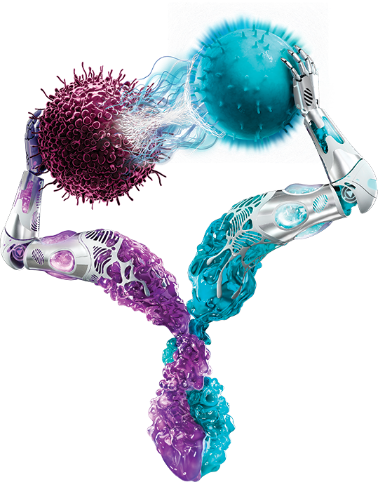
Adverse reactions were manageable1
Majority of ARs were mild to moderate (grade 1 or 2)
Most common treatment-related ARs (≥10%)
| Adverse Reaction* | All grades (%) | Grade 3 or 4 (%) |
|---|---|---|
| (n=86)† | ||
| Cytokine release syndromeठ| 49 | 0 |
| (n=127) | ||
| Injection site reactions|| | 58 | 0 |
| COVID-19¶ | 40 | 19 |
| Fatigue|| | 37 | 5# |
| Upper respiratory tract infection¶ | 29 | 2# |
| Musculoskeletal pain|| | 28 | 0.8# |
| Rash|| | 28 | 0 |
| Pyrexia|| | 26 | 2# |
| Diarrhea | 26 | 1.6# |
| Headache | 20 | 0 |
| Cough|| | 20 | 0 |
| Pneumonia¶ | 17 | 13# |
| Abdominal pain | 17 | 0.8# |
| Dyspnea|| | 17 | 0 |
| Edema|| | 17 | 0 |
| Nausea | 17 | 0 |
| Constipation | 16 | 0 |
| Arthralgia | 14 | 0.8# |
| Urinary tract infection|| | 13 | 5# |
| Peripheral neuropathy and paresthesia¶ | 13 | 1.6# |
| Neurological changes¶ | 13 | 0 |
| Insomnia | 13 | 0 |
| Herpes virus infection | 12 | 1.6# |
| Mucositis¶ | 12 | 0 |
| Dizziness | 11 | 0 |
| Renal insufficiency¶ | 10 | 1.6# |
*Adverse reactions were graded based on CTCAE Version 5.0.
†The frequency of CRS is based on 86 patients with 3L+ FL who received the recommended 3-step up dosage schedule in EPCORE® NHL-1 (see Dosage and Administration in Section 2.2 of the full Prescribing Information).
‡CRS was graded using ASTCT consensus criteria (Lee et al, 2019).
§The frequency of CRS based on the 127 patients with 3L+ FL who received the 2-step up dosage schedule in EPCORE® NHL-1 was the following: any grade CRS: 66%; grade 1 CRS: 50%; grade 2 CRS: 26%; grade 3 CRS: 1.6%.
IIIncludes related grouped terms.
¶Term includes other related terms. See full Prescribing Information.
#Only grade 3 adverse reactions occurred.
In 86 patients who received EPKINLY following the recommended 3-step up dosage schedule1:
- The median duration of exposure was 5 cycles (range: 1-12 cycles)1
- Permanent discontinuation of EPKINLY due to an adverse reaction occurred in 3.5% of patients (2.3% pneumonitis, 1.2% bronchopulmonary aspergillosis)2
- Dosage interruptions due to an adverse reaction occurred in 58.1% of patients (reactions occurring in ≥5%: CRS [19%] and COVID-19 [17%])1,2
- Serious adverse reactions occurred in 44% of patients (reactions occurring in ≥5% included: CRS [28%]). At the time of analysis, no fatal adverse reactions were observed1-3
- CRS occurred in 49% of patients, with Grade 1 CRS occurring in 45% and Grade 2 in 9% of patients1
In 127 patients who received EPKINLY following a 2-step up dosage schedule1:
- The median duration of exposure was 8 cycles (range: 1-33 cycles)
- Permanent discontinuation of EPKINLY due to an adverse reaction occurred in 19% of patients
- Adverse reactions that led to discontinuation in ≥2% of patients included COVID-19, hepatitis E, pneumonitis, and second primary malignancy
- Dosage interruptions due to an adverse reaction occurred in 59% of patients (adverse reactions occurring ≥5%: COVID-19, CRS, pneumonia, upper respiratory tract infection, and fatigue)
- Serious adverse reactions occurred in 66% of patients (reactions occurring in ≥5% included CRS, COVID-19, pneumonia, and second primary malignancies)
- Fatal adverse reactions occurred in 9% of patients, including COVID-19 (5%), pneumonitis (1.6%), cardiac failure (0.8%), pneumonia (0.8%), and sepsis (0.8%)
3L=third line; ARs=adverse reactions; ASTCT=American Society for Transplantation and Cellular Therapy; COVID-19=coronavirus disease of 2019; CRS=cytokine release syndrome; CTCAE=common terminology criteria for adverse events; FL=follicular lymphoma; ICANS=immune effector cell-associated neurotoxicity syndrome; NHL=non-Hodgkin lymphoma; ULN=upper limit of normal.




